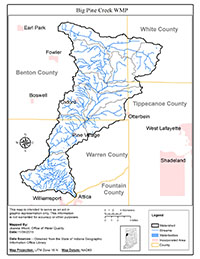Summary

This plan was prepared by the Indiana Chapter of The Nature Conservancy (the “Conservancy”), with guidance from the Big Pine Steering Committee. Funding was generously provided by the Nina Mason Pulliam Charitable Trust. The plan includes the Big Pine Creek and Mud Pine Creek watersheds drain into the Wabash River from portions of Benton, Tippecanoe, Warren, and White counties in west-central Indiana.
In the fall of 2007, The Nature Conservancy contracted with Midwest Biodiversity Institute to develop a comprehensive assessment of the current research related to water quality and diversity in the Wabash River. That assessment led to the development in 2010 of a list of Wabash River subwatersheds that were the largest contributors of sediment, nutrients, and other contaminants to the river. These watersheds were no regrets places to engage in watershed protection, develop the missing science to narrow down the stresses and then address those issues through education and on the ground best management practice installation. In total, approximately 20 such subwatersheds were chosen as potential project areas and prioritized for further work by the Conservancy and its partners.
In 2013, a proposal to the Pulliam Foundation was awarded to work on some of these priority watersheds, including Big Pine Creek in west central Indiana. The Big Pine had interested local support and it fell within the programmatic interests of potential partners such as the Wabash River Enhancement Corporation (WREC), Niches Land Trust, and the Conservation Technology and Information Center (CTIC). In the summer of 2013, the Conservancy assembled a group of partner organizations interested in improving water quality in the Big Pine, including WREC, Niches Land Trust, CTIC , Benton and Warren County Soil and Water Conservation Districts, and the Natural Resources Conservation Service (NRCS). This group formed a Steering Committee (Table 1), conducted windshield surveys of the watershed, and held several meetings open to the public in order to generate input in the development of a watershed management plan for the Big Pine.
All of these efforts were guided by the following mission and vision developed by public participants and committee members:
Mission: Voluntarily conserve and improve the natural environment while balancing interests of stakeholders in the Big Pine Creek watershed.
Vision: Big Pine Creek watershed is the anchor and an asset to the community.
